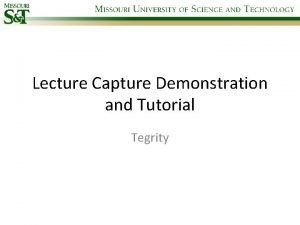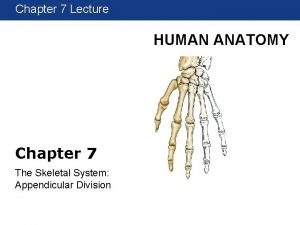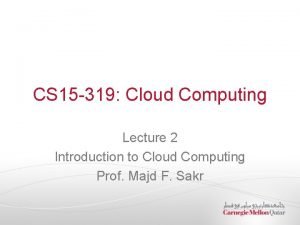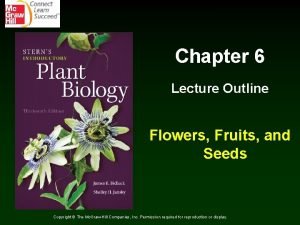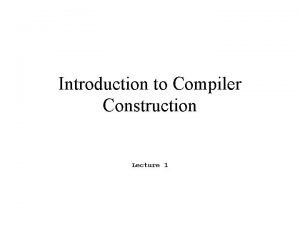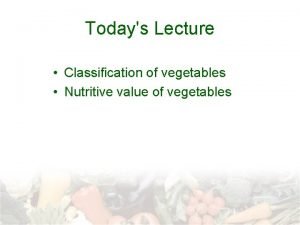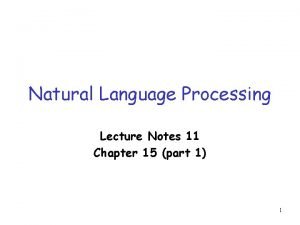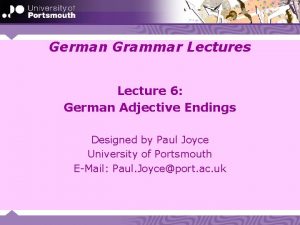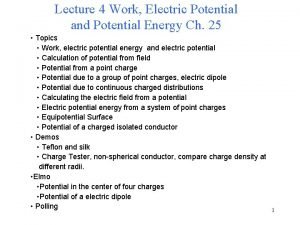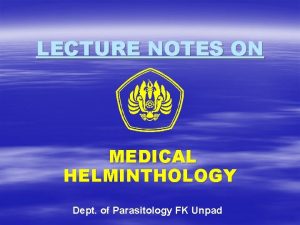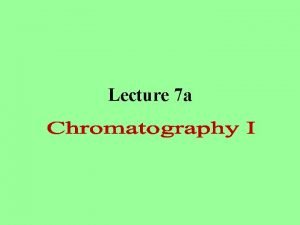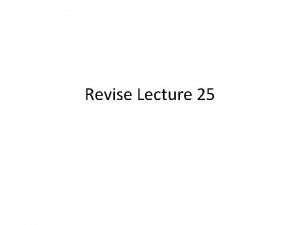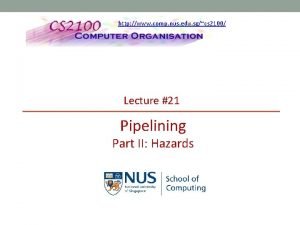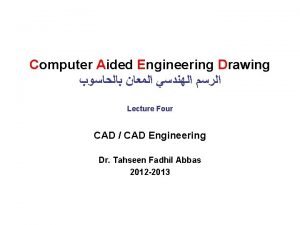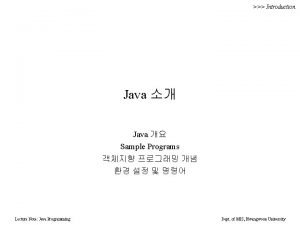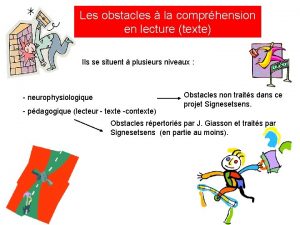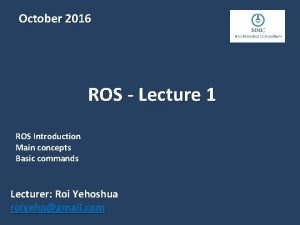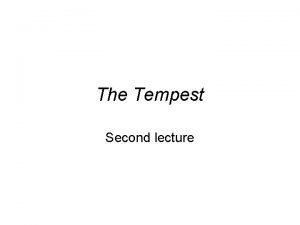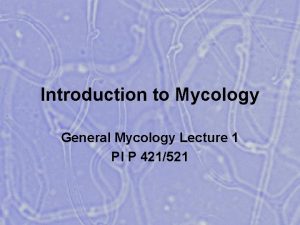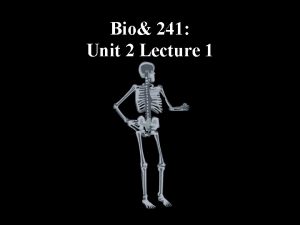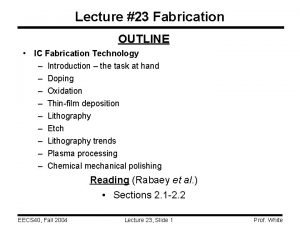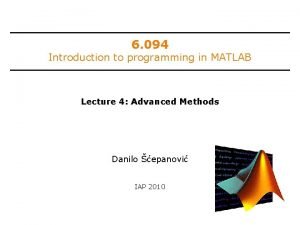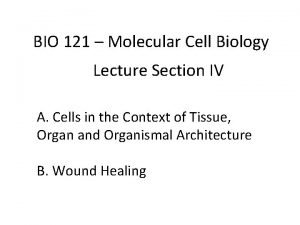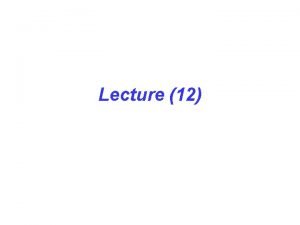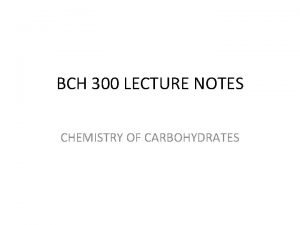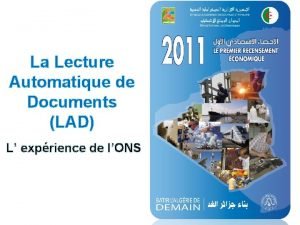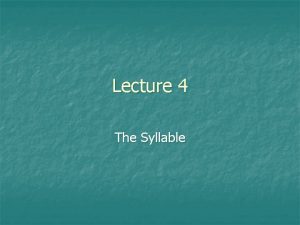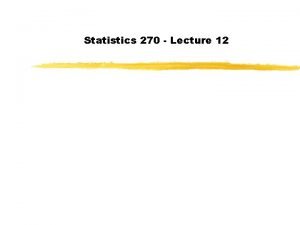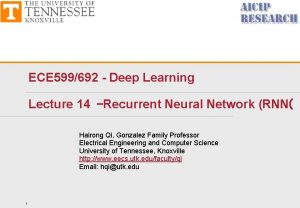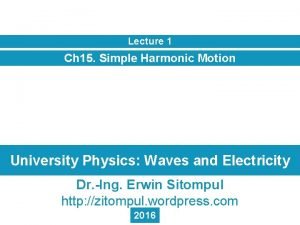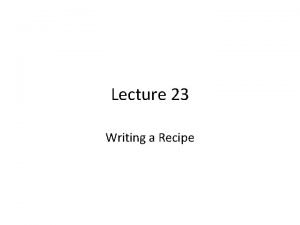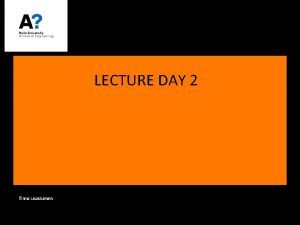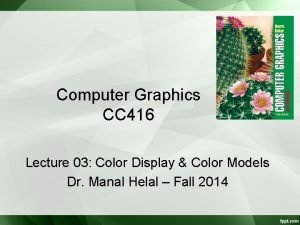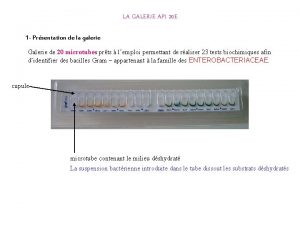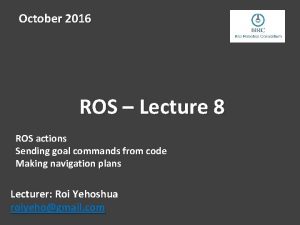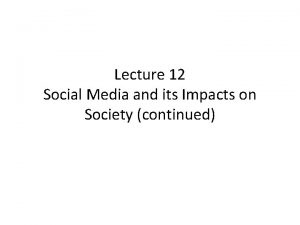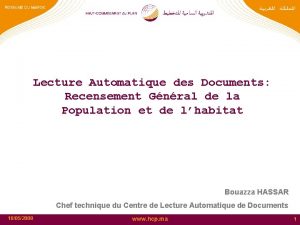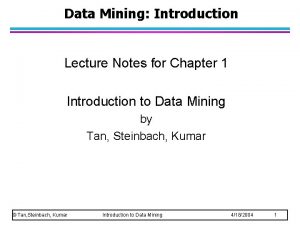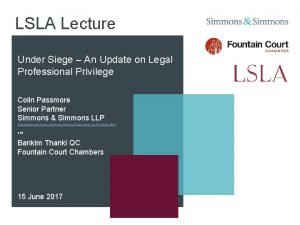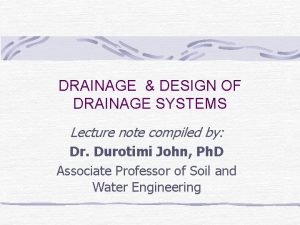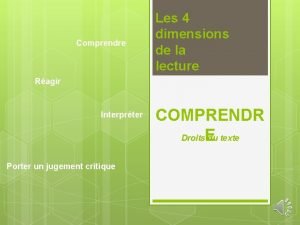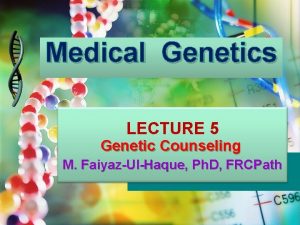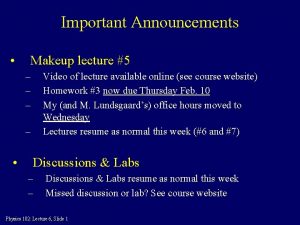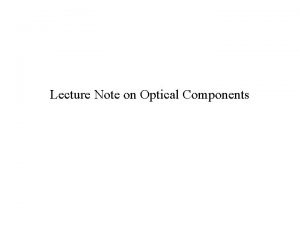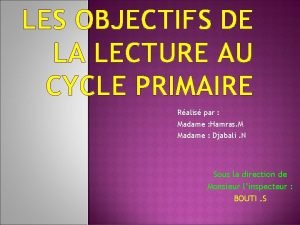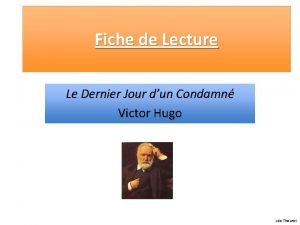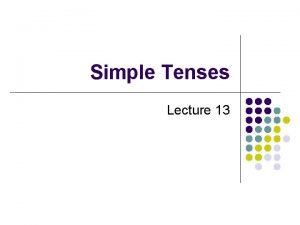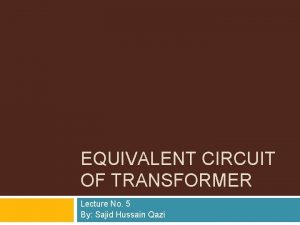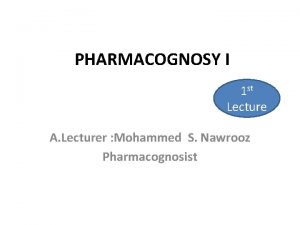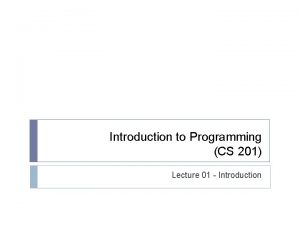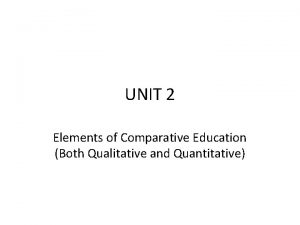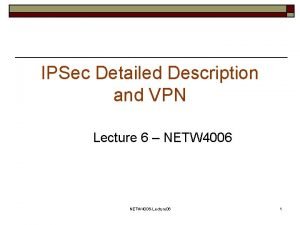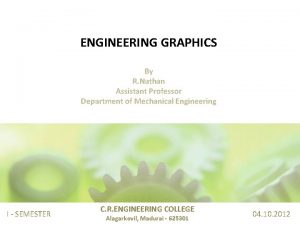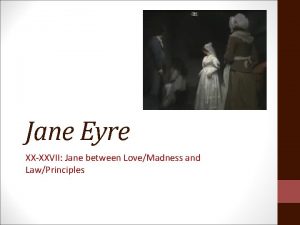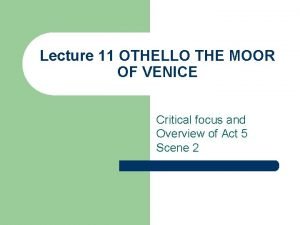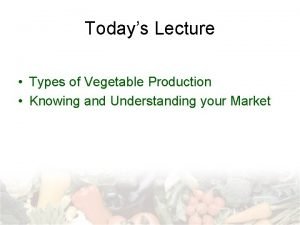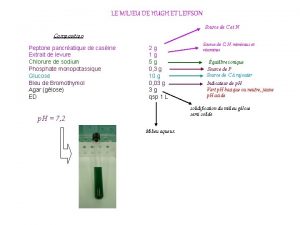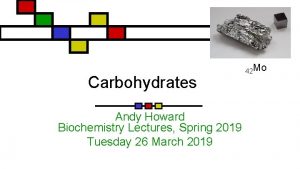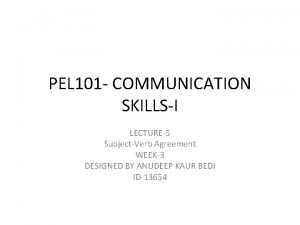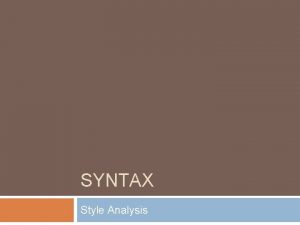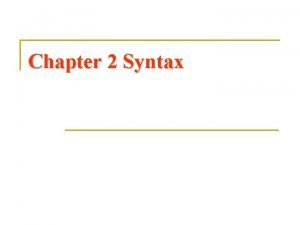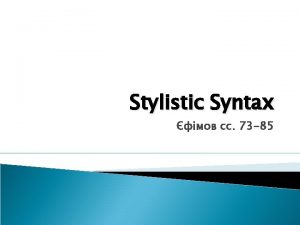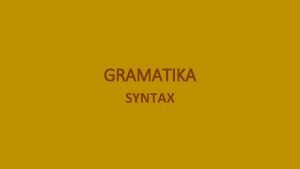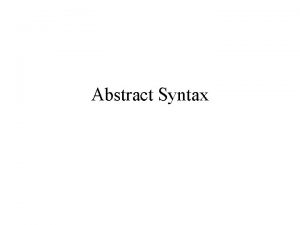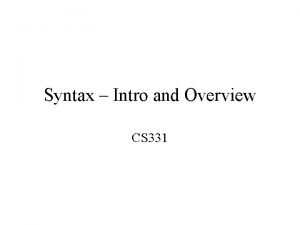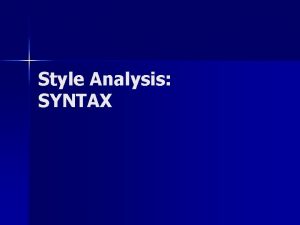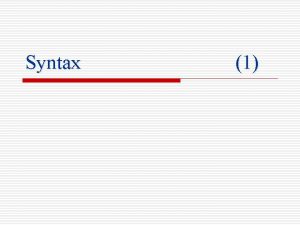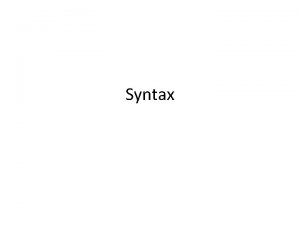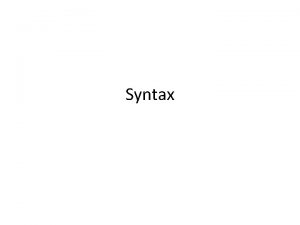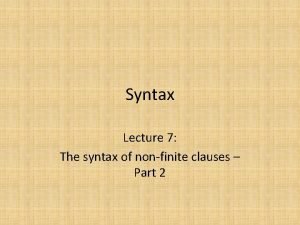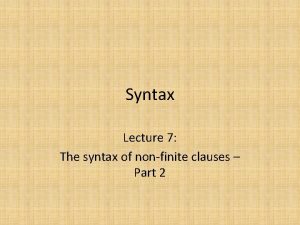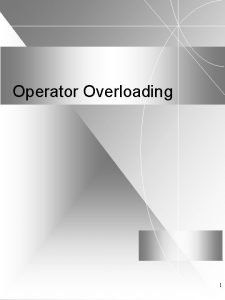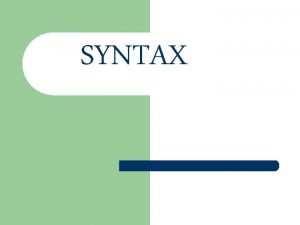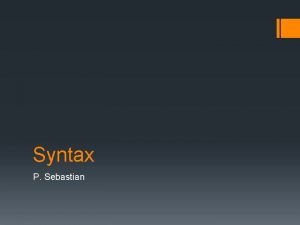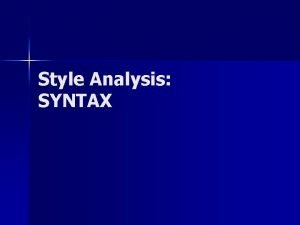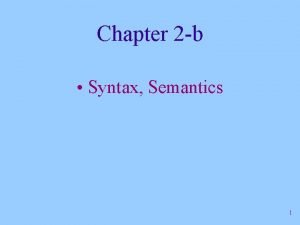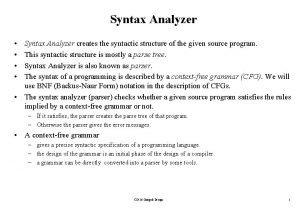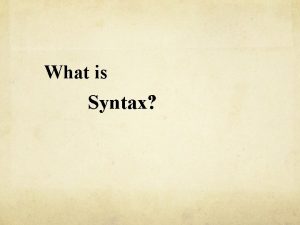Lecture 6 Syntax What is syntax SYNTAX is






























![• Coordination of NPs: • [NP the lady] or [NP the tiger] • • Coordination of NPs: • [NP the lady] or [NP the tiger] •](https://slidetodoc.com/presentation_image_h/2129be094cead99fa19de558400518fc/image-31.jpg)





































































- Slides: 100

Lecture 6 Syntax 句法学

What is syntax • SYNTAX is the study of the rules governing the ways different constituents are combined to form sentences in a language, or the study of the interrelationships between elements in sentence structures. It tries to answer two questions: • What words can occur together; • In what order the words are put together.

• 6. 1 Syntactic relations 句法关系 • 6. 2 Construction and constituents 结构与成 分 • 6. 3 Syntactic functions 句法功能 • 6. 4 Categories 范畴 • 6. 5 Phrase, clause and sentence • 6. 6 The extension of sentence • 6. 7 Syntax beyond the sentence

6. 1 Syntactic relations 句 法关系 • Syntactic relations can be analysed into three kinds, namely, positional relations (位 置 关 系 ), relations of substitutability( 替 换 关 系 ), and relations of co-occurrence (同现关系).

6. 1. 1 Positional relations • The boy kicked the ball. • Positional relation, or WORD ORDER, refers to the sequential arrangement of words in a language. If the words in a sentence fail to occur in a fixed order required by the convention of a language, one tends to produce an utterance either ungrammatical or nonsensical at all. • * Boy the ball kicked the. • * The ball kicked the boy.

• There are sentences in which when we change the word order, we get grammatical sentences that make sense, but the meaning may be just the opposite. • The boy laughed at the girl. • The girl laughed at the boy.

• Positional relations are a manifestation of one aspect of SYNTAGMATIC RELATIONS (组合关系 ). This was first observed by F. de Saussure (1857 -1913). They are also called HORIZONTAL RELATIONS or simply CHAIN RELATIONS (链状 关系). So far as word order or positional relation is concerned, they are SVO, VSO, SOV, OVS, OSV, and VOS. English belongs to SVO type, though this does not mean that SVO is the only possible word order.

6. 1. 2 Relation of substitutability • The RELATION OF SUBSTITUTABILITY refers to classes or sets of words substitutable for each other grammatically in sentences with the same structure. • The ____ smiles. • We can fill in here several different words: man, woman, boy, girl, student, teacher, etc. These words are in the relation of substitutability.

• This relationship does not refer to individual words only. It refers to groups of more than one word which together may be substitutable grammatically for a single word of a particular set.

• This is what Saussure called ASSOCIATIVE relations ( 联 想 关 系 ), or in Hjemslev's term, PARADIGMATIC relations (聚合关系). To make it more understandable, they are called VERTICAL relations or CHOICE relations (选择关系)

6. 1. 3 Relation of cooccurrence • By the relation of CO-OCCURENCE one means that words of different sets of clauses may permit, or require, the occurrence of a word of another set or class to form a sentence or a particular part of a sentence.

• Thus relations of co-occurrence partly belong to syntagmatic relations, partly to paradigmatic relations.

6. 2 Construction and constituents • The boy kicked the ball. • A sentence not only has a linear structure, that is, it consists of individual words one after another in a line; it also has a hierarchical structure – it’s made up of layers of word groups. The relationship between a sentence and its component elements is usually referred to as the relationship between a grammatical construction and its constituents.

6. 2. 1 Immediate Constituent analysis 直接成分分析 • This idea was first put forward by Leonard Bloomfield. According to him, any construction can be cut into immediate constituents – word groups, which can be further cut into its own immediate constituents – words. Finally, we reach the ultimate constituent (最 终 成 分 ) – morphemes. Usually we stop at the level of words.

The boy kicked the ball This tree contains three Nodes. The top-most node, A, is the mother of the two lower nodes (节), B and C are Daughters of the same mother, and so we refer to them as Sister nodes. The simple tree in the above represents a constituent of category A which is composed of two parts, one of category B and the other of category C, occurring in that order.

The boy kicked the ball

• Another way to present the immediate constituents is by bracketing, which is used less common but more economical. • (((The) (boy)) ((ate) ((the) (apple))))

• How do we decide where the cut should be? The principle is substitutability. That is, whether it’s possible to replace the sequence of words in the constituent by a single word.

• This immediate constituent analysis method has a big advantage: it can help to clear ambiguity. • leave the book on the shelf put the book on the shelf don’t move the book

• leave the book on the shelf

• Sometimes we need a labeled tree diagram to reveal this ambiguity. • Is he really that kind? • Det N • NP • Is he really that kind? • adv. adj. AP

• But this IC analysis also has its problems. For example, it can’t show ambiguity in a word group like “the love of God” and “the shooting of hunters”. This analysis cannot make clear whether God is the subject or object of “love”, or whether “hunters” is the subject or object of “shooting”.

6. 2. 2 Endocentric and Exocentric constructions • The syntactic constructions can be classified into two main types: endocentric and exocentric constructions, depending on their distribution and the relation between their constituents.

6. 2. 2. 1 Endocentric • ENDOCENTRIC construction is one whose distribution is functionally equivalent to that of one or more of its constituents, i. e. , a word or a group of words, which serves as a definable CENTRE or HEAD. That is to say, endocentric constructions are literal expansions of its constituent, and the construction is in a relationship of substitutability of the head. The construction and the head are syntactically equivalent.

• Usually noun phrases, verb phrases and adjective phrases belong to endocentric types because the constituent items are subordinate to the Head.

• • • More complicated examples include: will have already been leaving; really very late; the man about whom I have been talking swimming in the lake; hot beyond endurance

6. 2. 2. 2 Exocentric • EXOCENTRIC construction is just the opposite of endocentric construction. It refers to a group of syntactically related words where none of the words is functionally equivalent to the group as a whole, that is, there is no definable “Centre” or “Head” inside the group. Exocentric construction usually includes basic sentence, prepositional phrase, predicate (verb + object) construction, and connective (be + complement) construction.

• (a) The boy smiled. (Neither constituent can substitute for the sentence structure as a whole. ) • (b) He hid behind the door. (Neither constituent can function as an adverbial. ) • (c) He kicked the ball. (Neither constituent stands for the verb-object sequence. ) • (d) John seemed angry. (After division, the connective construction no longer exists. )

6. 2. 3 Subordination and coordination 从属与并列 • Endocentric constructions fall into two main types, depending on the relation between constituents: coordination and subordination.

6. 2. 3. 1 Coordination • COORDINATION is a common syntactic pattern in English and other languages formed by grouping together two or more categories of the same type with the help of a conjunction such as and, but and or. This phenomenon is known as coordination. And these two or more words or phrases or clauses have equivalent syntactic status, each of the separate constituents can stand for the original construction functionally.
![Coordination of NPs NP the lady or NP the tiger • Coordination of NPs: • [NP the lady] or [NP the tiger] •](https://slidetodoc.com/presentation_image_h/2129be094cead99fa19de558400518fc/image-31.jpg)
• Coordination of NPs: • [NP the lady] or [NP the tiger] • Coordination of VPs: • [VP go to the library] and [VP read a book ] • Coordination of PPs: • [PP down the stairs] and [PP out the door ] • Coordination of APs: • [AP quite expensive] and [AP very beautiful] • Coordination of Ss: • [S John loves Mary] and [S Mary loves John too].

• One property coordination reveals is that there is no limit on the number of coordinated categories that can appear prior to the conjunction. Thus, we can form structures in which the subject NP contains four smaller NPs prior to the underlined conjunction and one after it: • [NP A man, a woman, a boy, a cat and a dog] got into the car. • Therefore, coordination occupies its own place in the creativity of language: recursiveness (递归性).

6. 2. 3. 2 Subordination • SUBORDINATION refers to the process or result of linking linguistic units so that they have different syntactic status, one being dependent upon the other, and usually a constituent of the other. Thus the subordinate constituents are words which modify the Head, as shown in the underlined parts of the constructions. Consequently, they can be called modifiers.

• (a) two dogs Head • (b) (My brother) can drink (wine). • Head • (c) Swimming in the lake (is fun). • Head • (d) (The pepper was) hot beyond endurance. • Head

• Certainly, clauses can be used as subordinate constituents, the three basic types of subordinate clauses are: complement clauses, adjunct (or adverbial) clauses, and relative clauses. • (a) John believes [that the airplane was invented by an Irishman]. (complement clause) (b) Elizabeth opened her presents [before John finished his dinner]. (adverbial clause) (c) The woman [that I love] is moving to the south. (relative clause).

• I met a man who had a son whose wife sold cookies that she had baked in her kitchen that was fully equipped with electrical appliances that were new.

6. 3 Syntactic functions • The SYNTACTIC FUNCTION shows the relationship between a linguistic form and other parts of the linguistic pattern in which it is used. • Names of functions are expressed in terms of subjects, objects, predicators, modifiers, complements, etc.

6. 3. 1 Subject • In some languages, subject refers to one of the nouns in the nominative case. • The typical example can be found in Latin, where subject is always in nominative case, such as pater and filius in the following examples. – pater filium amat (the father loves the son) – patrum filius amat (the son loves the father)

• In English, the subject of a sentence is often said to be the agent, or the doer of the action, while the object is the person or thing acted upon by the agent. – This definition seems to work for these sentences: – Mary slapped John. ■ A dog bit Bill.

• but is clearly wrong in the following examples: – John was bitten by a dog. – John underwent major heart surgery. • In order to account for the case of subject in passive voice, we have two other terms “grammatical subject” (John) and “logical subject” (a dog).

• Another traditional definition of the subject is “what the sentence is about” (i. e. , topic). • Again, this seems to work for many sentences, such as – Bill is a very crafty fellow. • but fails in others, such as – (Jack is pretty reliable, but) Bill I don’t trust. – As for Bill, I wouldn’t take his promises very seriously.

• Traditionally we distinguish between three types of subjects: • Psychological subject: the starting point of a message; the first element in a sentence; • Grammatical subject: the element which shows certain grammatical relations, e. g. , the noun in a nominative case; the noun which the verb agrees with; • Logical subject: the doer of an action.

• • • M. A. K. Halliday : psychological subject – theme; grammatical subject – subject; logical subject – actor. According to Halliday, the three things may or may not be realized by the same element in a sentence.

• • 1. Mother has given my brother this toy. theme, subject and actor. • • 2. My brother has been given this toy by Mother. theme, subject actor • • 3. This toy my brother has been given by Mother. theme subject actor • • 4. This film I have already seen many times. theme subject, actor • • 5. Most of the sentences we hear we have never heard before. theme subject, actor

• • In Chinese, there are even more problems with the notion subject. Traditionally we depend on the meaning to decide which is the subject. There is little formal indication: verbs don’t inflect, nouns don’t have cases, etc. 这 本 书 我 看 完 了。 前置宾语 主语 饭 吃 完 了。 鸡 不 吃 了。

• 赵 元 任 (1892 -1982), the best known Chinese linguist in the world, proposes to talk about topic and comment instead of subject and predicate in Chinese. • 我 们 今 天 种 树。 • topic comment • 今 天 我 们 种 树。 • topic comment

Properties of subjects in English • • • A. Word order: Subject ordinarily precedes the verb in statement: a. Sally collects stamps. b. *Collects Sally stamps. • B. Pro-forms: The first and third person pronouns in English appear in a special form when the pronoun is a subject. This form is not used when the pronoun occurs in other positions: a. He hates me. b. I hate him. c. We threw stones at them. d. They threw stones at us. C. Agreement with verb: In the simple present tense, an –s is added to the verb when a third person subject is singular. However, the number and person of the object or any other element in the sentence have no effect at all on the form of the verb: a. She angers him. b. They anger him. c. She angers them. • • •

• D. Content questions: if the subject is replaced by a question word (who or what), the rest of the sentence remains unchanged. But when any other element of the sentence is replaced by a question word, an auxiliary verb must appear before the subject. If the basic sentence does not contain an auxiliary verb, we must insert did or do(es) immediately after the question word. • (a) John stole/would steal Mrs. Thatcher‘s picture from the British Council. • (b) Who stole/would steal Mrs. Thatcher's picture from the British Council? • (c) What would John steal, if he had the chance? • (d) What did John steal from the British Council? • (e) Where did John steal Mrs. Thatcher's picture from? • •

• E. Tag question: A TAG QUESTION is used to seek confirmation of a statement. It always contains a pronoun which refers back to the subject, and never to any other element in the sentence. • (a) John loves Mary, doesn't he? • (b) Mary loves John, doesn't she? • (c)*John loves Mary, doesn't she?

6. 3. 2 Predicate 谓语 • PREDICATE refers to a major constituent of sentence structure in a binary analysis in which all obligatory constituents other than the subject were considered together. It usually expresses actions, processes, and states that refer to the subject. • (a) The boy is running. • (b) Peter broke the glass. • (c) Jane must be mad!

• As predicate includes constituents such as verb, object, complement, etc. , people find it illogical to use a class-term, namely, the verb, in grammatical analysis of a functional nature. The word PREDICATOR is suggested by Randolph Quirk for verbs included in a predicate.

6. 3. 3 Object • OBJECT is a term related to subject. Since, traditionally, subject can be defined as the doer of the action, object may refer to the “receiver” or “goal” of an action – what the action is directed at. It is further classified into DIRECT OBJECT and INDIRECT OBJECT. • (a) Mother bought a doll. • (b) Mother gave my sister a doll. • Ind. Obj. Dir. Obj.

• In some inflecting languages, object is marked by case labels: the accusative case for direct object, and the dative case for indirect object. • Herr Braun gibt dem Gast den Füller. dative accusative • Der Freund Kauft dem Kind eine Uhr. dative accusative

• In English, “object” is recognised by tracing its relation to word order (after the verb and preposition) and by inflections (of pronouns). • I met him yesterday. • He saw me yesterday. • She resembles her mother.

• Not every noun that occurs after the verb is the object. Only those that can function as subjects in passive sentences can be called objects. • (a) He died last week. • (b) The match lasted three hours. • (c) He weighed 100 pounds.

6. 3. 4 The relation between classes and functions • Classes and functions determine each other, but not in any one-to-one relation. A class item can perform several functions. For instance, a noun or a nominal phrase can function as the subject, object, modifier, adverbial and complement of a sentence. • (a) The boys are playing football. (Subj. and Obj. ) • (b) the Summer Palace (Modifier) • (c) He came here last month. (Adv. ) • (d) He changed trains at Fengtai. (Comp. )

• Similarly, a function can be fulfilled by several classes. For instance, the subject of a sentence can be realized by a noun, pro-noun, numeral, infinitive, etc. • (a) The dog is barking. (Nominal) • (b) We will stay here. (Pronoun) • (c) Only two-thirds of the population here are • workers. (Numeral) • (d) To run fast can be dangerous. (Verbal)

6. 4 Category 范畴 • The term CATEGORY in some approaches refers to classes and functions in its narrow sense, e. g. , noun, verb, subject, predicate, noun phrase, verb phrase, etc. More specifically, it refers to the defining properties of these general units: the categories of the noun, for example, include number, gender, case and countability; and of the verb, for example, tense, aspect, voice, etc.

6. 4. 1 Number 数 • NUMBER is a grammatical category used for the analysis of word classes displaying such contrasts as singular, dual, plural, etc. • In English, number is mainly observed in nouns, and there are only two forms: singular and plural, such as dog: dogs. • Number is also reflected in the inflections of pronouns and verbs, such as he laughs: they laugh; this man: these men.

• In other languages, for example, French, the manifestation of number can also be found in adjectives and articles. • (a) le cheval royal (the royal horse) • (b) les chevaux royaux (the royal horses)

• Chinese doesn’t have inflection, but there is a character that suggests the plurality of the noun – 们. However, this character is not used with all nouns – it’s used only with nouns denoting human beings. • 老师们都说今年的四级题目比去年容易。

• When there is a determiner or modifier, usually this character is no longer needed: 通常勤奋的学生成绩会更好。 • This character is not used with animal words and inanimate nouns: 春天来了,小鸟在歌唱,花儿在绽放。 我们把桌子和椅子重新摆一下。

6. 4. 2 Gender 性 • In English, nouns have natural genders. That is to say, the gender of the word corresponds to the natural sex of what is referred to. • Example: actor, actress; prince, princess; hero, heroine. • English gender contrast can only be observed in pronouns and a small number of nouns, and, they are mainly of the natural gender type. • Example:he, she, it

• In French and German, not only those nouns that refer to people have a gender, but every noun has a gender. That is grammatical gender. The French language distinguishes between two genders: feminine and masculine, while in German there are three: feminine, masculine and neuter. • Though there is a statistical correlation between natural gender and grammatical gender, the assignment may seem quite arbitrary in many cases. • Example: la chemise (shirt for men) le chemisier (shirt for women)

• In French, adjectives also have their genders, depending on the nouns they modify. • beau cadeau (fine gift) • belle maison (fine house) • Le cadeau est beau. (The gift is good. ) La maison est belle. (The house is beautiful. )

• Also, there is the possibility that when the gender of a noun is changed, the meaning is changed as well: le pendule (the pendulum), la pendule (the clock)

• In Chinese, word gender usually corresponds to natural gender. That is to say, words with “女 ” as the radical are usually used to refer to women or etymologically related to women. • 姑,娘,嫁,娶,妈,姨,

6. 4. 3 Case格 • The category of case is used in the analysis of word classes to identify the syntactic relationship between words in a sentence. •

• In Latin grammar, cases are based on variations in the morphological forms of the word, and there are 6 cases in Latin: • nominative case (主格), used with subjects; • vocative (呼 格 ), used when addressing someone; • accusative (宾格), used with direct objects; • dative (与格), used with indirect objects; • genitive (属格), the possessive case; • ablative (夺格), the source, agent, cause or instrument of some action.

• There are five cases in ancient Greek and eight in Sanskrit. Finnish has as many as fifteen formally distinct cases in nouns, each with its own syntactic function.

• Nouns in English have two cases only: general, referring to nouns in the normal form, for example, John, teacher; genitive or possessive, marked as ’s, for example, John’s, the teacher’s. Personal pronouns in English have a third case, accusative, for example, me, him, her, us, and them.

• The English case may reflected by other means: also be – following a preposition – word order • as manifested in – with : to a man – John kicked Peter : Peter kicked John

6. 4. 4 Agreement / Concord 一致关系 • Agreement / Concord refers to the requirement that two or more words in a certain syntactic relationship agree with each other in terms of form. That is to say, these words should be characterized by the same paradigmatically marked category (or categories).

• This syntactic relationship may be anaphoric, as when a pronoun agrees with its antecedent. • Whose is this pen? Oh, it's the one I lost. • Or it may involve a relation between a head and its dependent, as when a verb agrees with its subject and object. • Each person may have one coin. • He walks. They walk.

• The features of the head noun which may be reflected in the agreeing dependent forms are what we have described above: gender, number, and case. Agreement between gender and number should be shown in noun-adjective relation in French: • beau cadeau (fine gift) • belle maison (fine house) • Le cadeau est beau. (The gift is good. ) • La maison est belle. (The house is beautiful. )

6. 5 Phrase, clause and sentence • Phrase refers to a group of words that are not in a subject-predicate relationship. Traditionally, it is seen as part of a structural hierarchy, between clause and word. Therefore, first, a phrase must be a group of words which form a constituent. Second, a phrase is lower on the grammatical hierarchy than clauses. That is to say, simple clauses may (and usually do) contain phrases, but simple phrases do not (in general) contain clauses.

• • • We have different types of phrases: the three tallest girls (nominal phrase) has been doing (verbal phrase) extremely difficult (adjectival phrase) to the door (prepositional phrase) very fast (adverbial phrase)

• However, there is a tendency to make a distinction between WORD GROUP and PHRASE. A word group is an extension of word of a particular class by way of modification with its main features of the class unchanged. Halliday uses the term “word group” only to noun-phrases. He calls word groups with prepositions as “prepositional phrase” as this is usually an exocentric construction and there is no head in it. Actually we can have nominal group, verbal group, adverbial group, conjunction group and preposition group (e. g. right behind, all along).

6. 5. 2 Clause 小句 • Clause refers to a group of words in a subject-predicate relationship. Clauses are further divided into finite clauses and non-finite clauses, the former with a finite verb, the latter including the traditional infinitive phrase, participial phrase, and gerundial phrase.

• • (a) The best thing would be to leave early. (b) It's great for a man to be free. (c) Having finished their task, they came to help us. (d) Xiao Li being away, Xiao Wang had to do the work. (e) Filled with shame, he left the house. (f) All our savings gone, we started looking for jobs. (g) It's no use crying over spilt milk. (h) Do you mind my opening the window?

6. 5. 3 Sentence • According to Bloomfield, sentence is an independent linguistic form which is not included in other linguistic forms. That is to say, sentence is the largest grammatical unit.

Structural classification

Functional classification

• Some linguists are now interested in the communicative function of utterances and label various sentences as “statement”, “question”, “command”, “request”, “confirmation”, etc.

• Based on word classes, Bolinger (1969) reports five basic sentence types. • Nominal + intransitive verbal: Mother fell. • Nominal + copula + complement: Mother is ill. • Nominal + transitive verbal + nominal: Mother loves the family. • Nominal + transitive verbal + nominal: Mother feds the baby breakfast. • There + existential + nominal: There is a letter.

• • Quirk, et al (1972) introduces seven sentence types according to the grammatical functions of the constituents involved in a sentence. (a) SVC C-complement, traditionally called predicative after the link verb. Mary is kind. Mary is a nurse. (b) SVA A- Adverbial which is traditionally optional. Quirk discovered that adverbial may be obligatory. Mary is here / in the house. In answers like “Yes, Mary is. ” “Here” is elliptical and the structure is incomplete. (c) SV Subject + intransitive verb, e. g. The child is laughing. (d) SVO Subject + vt. + object, e. g. , Somebody caught the ball. (e) SVOC Subject + vt. + Object + O. C. e. g. , We have proved him wrong / him a fool. (f) SVOA Subject + vt. + O. + adverbial I put the plate on the table. (g) SVOO Subject + vt. + Indirect O. + direct O. She gives me expensive presents.

6. 6 Recursiveness 递归性 • Recursiveness mainly means that a phrasal constituent can be be dominated by another constituent having the same category. But today it is used more often as a cover term to include different important linguistic phenomena such as coordination and subordination, conjoining and embedding, hypotactic and paratactic.

6. 6. 1 Conjoining vs. embedding 连接与嵌入 • CONJOINING refers to the process where one clause is coordinated or conjoined with another. The sentences made up in this way can be understood as instances of coordination. The conjunctions used in this case are and, but, and or. • (a) John bought a hat and his wife bought a handbag. (b) You must be quick or you’ll be late. (c) He is poor, but he is honest.

• EMBEDDING refers to the means by which one clause is included in the sentence (main clause) in syntactic subordination. The three basic types of subordinate clause are complement, adjunct (or adverbial) and relative clauses. Conjunctions like when, where, since, if, that, who, etc. are used in this case. • (a) I saw the man who had visited you last year. (relative clause) (b) I don't know whether Professor Li needs this book. (complement clause) (c) If you listened to me, you wouldn't make mistakes. (adverbial clause)

6. 6. 2 Hypotactic vs. paratactic relations形合与 意合 • Hypotactic relation refers to a construction where constituents have been linked through the use of conjunctions. • He bought eggs and milk. • The man laughed when the dog barked. • He dictated the letter and she wrote it.

• Paratactic relation refers to constructions which are linked through juxtaposition and punctuation or intonation, and not through the use of conjunctions. • He bought tea, coffee, eggs and milk. • I think it is so. • 他们爱祖国,爱人民,爱正义,爱和平。 • 你不让我去,我自己去。 • 明天不下雨,我一定来。

6. 6. 3 Recursiveness 循环, 递归 • Recursiveness, in the narrow sense, refers to the repetition of the same element in a sentence. For example: • This is very, very good. (single word) • Francis Bacon was said to be the wisest, brightest, meanest of mankind. (grammatical function)

• Clauses can also be repeated. This recursiveness is shown in children’s rhyme. • This is the farmer sowing the corn— • That kept the cock that crowed in the morn, • That waked the priest all shaven and shorn, • That married the man all tattered and torn, • That kissed the maiden all forlorn, • That milked the cow with the crumpled horn, • That tossed the dog, • That worried the cat, • That killed the rat, • That ate the malt, • That lay in the house that Jack built.

6. 7 Beyond the sentence • The development of modern linguistic science has helped push the study of syntax beyond the traditional sentence boundary. More linguists are now exploring the syntactic relation between sentences in a paragraph or chapter or the whole text, which leads to the emergence of TEXT LINGUISTICS and DISCOURSE ANALYSIS.

6. 7. 1 Sentential connection — Hypotactic • You can phone the doctor if you like. However, I very much doubt whether he is in. • We live near the sea. So we enjoy a healthy climate. — Paratactic (coordinate clauses): • In Guangzhou it is hot and humid during the summer. In Beijing it is hot and dry. • He dictated the letter. She wrote it. • The door was open. He walked in.

6. 7. 2 Cohesion 衔接 • Cohesion is a concept that is used with discourse or text instead of syntax. It refers to relations of meaning that exist within the text, and defines it as a text. Discoursal/textual cohesiveness can be realized by employing various cohesive devices.

• According to Halliday, there are five types of cohesive device: • 1) Reference 照应 This is mainly realized by pronouns or the traditional demonstratives like this, that, etc. John is 19. He is a university student. He couldn't open the door. It was locked tight. • • • 2) Substitution 替代 This is mainly realized by pro-forms. Are you going to Xiangshan? Yes, I’m going there. “Why don't you use your own recorder? ” “I don't have one. ”

• • • 3) Ellipsis 省略 This goes a step further than substitution. Do you like it? No, I don’t (like it). Did she get there at six? No, (she got there) earlier (than six). • • 4) Logical connection This is realized by adverbs or conjunctions showing the logical connection. For example, first, second, etc. shows the sequence; as a result shows the consequence. I wanted to help him. Unfortunately it was too late. • • • 5) Lexical cohesion He fell asleep. What woke him was a loud crash. Everyone cheered. The leader acknowledged the applause.

Define the following terms: • syntax, co-occurence, syntagmatic relation, paradigmatic relation, construction, constituents, endocentric construction, exocentric construction, subordination, coordination, grammatical subject, logical subject, category, agreement, recursiveness, embedding, conjoining, cohesion,

Questions: • Use examples to illustrate different ways to extend syntactic constituents. • Explain the main characteristics of subjects in English. • Use examples to illustrate Immediate Constituent Analysis and discuss its advantages and disadvantages.
 01:640:244 lecture notes - lecture 15: plat, idah, farad
01:640:244 lecture notes - lecture 15: plat, idah, farad Syntax of mkleaf is
Syntax of mkleaf is Tegrity lecture capture
Tegrity lecture capture Sltpttch
Sltpttch Lecture title
Lecture title Cmu cloud computing
Cmu cloud computing Dehiscent vs indehiscent
Dehiscent vs indehiscent If the lexical analyzer finds a token invalid then?
If the lexical analyzer finds a token invalid then? Lecture vegetables
Lecture vegetables Psaume 23 comme lecture sainte cène
Psaume 23 comme lecture sainte cène Natural language processing lecture notes
Natural language processing lecture notes Adjective endings german
Adjective endings german Public sector definition
Public sector definition Land use planning lecture notes
Land use planning lecture notes Electric potential lecture
Electric potential lecture Dyphilidium caninum
Dyphilidium caninum Power system dynamics and stability lecture notes
Power system dynamics and stability lecture notes Unified health management information system
Unified health management information system Sargur srihari
Sargur srihari Computer security 161 cryptocurrency lecture
Computer security 161 cryptocurrency lecture Things fall apart traditions and customs
Things fall apart traditions and customs Sons voyelles
Sons voyelles Exemple de lecture dirigée
Exemple de lecture dirigée Hydrology lecture
Hydrology lecture Randy pausch the last lecture summary
Randy pausch the last lecture summary Introduction to chromatography
Introduction to chromatography What are the features of cheque
What are the features of cheque Lecture title
Lecture title Nus lecture
Nus lecture Drawing lecture
Drawing lecture Foundation engineering lecture notes
Foundation engineering lecture notes Eclipse erd
Eclipse erd Phlebotomy lecture
Phlebotomy lecture Les obstacles de la lecture
Les obstacles de la lecture Ros lecture
Ros lecture Physics 101 lecture
Physics 101 lecture Bioinformatics lecture
Bioinformatics lecture Prospero
Prospero Mycology lecture
Mycology lecture Tarsals lecture
Tarsals lecture Fuzzy logic lecture
Fuzzy logic lecture Basic planar process in ic fabrication
Basic planar process in ic fabrication Matlab lecture
Matlab lecture Principles of economics powerpoint lecture slides
Principles of economics powerpoint lecture slides Fibroblast
Fibroblast Medsoderm
Medsoderm Shape memory alloys lecture notes
Shape memory alloys lecture notes Tarsals lecture
Tarsals lecture Chemistry of carbohydrates notes
Chemistry of carbohydrates notes Slidetodoc.com
Slidetodoc.com Lecture automatique de document
Lecture automatique de document Syllable tree
Syllable tree A college professor never finishes his lecture
A college professor never finishes his lecture 50h8 tolerance
50h8 tolerance Lecture outline meaning
Lecture outline meaning Lstm lecture
Lstm lecture Simple harmonic motion lecture
Simple harmonic motion lecture Lecture recipe
Lecture recipe Lecture day
Lecture day Lecture
Lecture La galerie api 20e
La galerie api 20e Lecture outline example
Lecture outline example Roi yehoshua
Roi yehoshua Geology lecture series
Geology lecture series Lecture about social media
Lecture about social media Lecture automatique de questionnaires
Lecture automatique de questionnaires Requirement analysis in software engineering notes
Requirement analysis in software engineering notes Data mining lecture notes
Data mining lecture notes Siege lecture
Siege lecture Types of drainage
Types of drainage Les 4 dimensions de la lecture
Les 4 dimensions de la lecture La petite fille au kimono rouge questionnaire
La petite fille au kimono rouge questionnaire Medical genetics lecture
Medical genetics lecture Microbial physiology and metabolism lecture notes
Microbial physiology and metabolism lecture notes Types of lecture method
Types of lecture method Make up lecture
Make up lecture Healthy lifestyle wrap up lecture
Healthy lifestyle wrap up lecture Optical amplifiers lecture notes
Optical amplifiers lecture notes Les objectifs de la lecture
Les objectifs de la lecture Fiche de lecture le dernier jour d'un condamné
Fiche de lecture le dernier jour d'un condamné Lecture past tense
Lecture past tense Human resources management chapter 1
Human resources management chapter 1 Intermediate microeconomics lecture notes
Intermediate microeconomics lecture notes Practical transformer equivalent circuit
Practical transformer equivalent circuit Lecture is derived from
Lecture is derived from Cell and molecular biology lectures
Cell and molecular biology lectures Define pharmacognosy
Define pharmacognosy Practical design to eurocode 2
Practical design to eurocode 2 Cs201 lecture 1
Cs201 lecture 1 Comparative education
Comparative education Vpn lecture
Vpn lecture Business communication lecture slides
Business communication lecture slides Drawing lecture
Drawing lecture Lecture villa dr najeeb
Lecture villa dr najeeb Othello lecture
Othello lecture Vegetable lecture
Vegetable lecture Data mining lecture notes
Data mining lecture notes Charging by induction
Charging by induction épreuve de hugh et leifson
épreuve de hugh et leifson Carbohydrates biochemistry lecture
Carbohydrates biochemistry lecture A lecture on subject-verb agreement
A lecture on subject-verb agreement


